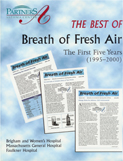Breath of Fresh Air: Feature Articles
Chapter 17: Acupuncture Asthma
|
Asthma care can be frustrating. Inhaled medications can be tricky to use properly. Daily medications can feel like a burden and may cause some unpleasant side effects. Many people worry about the potential for harmful effects with long-term use of medications. Even faithful adherence to treatment programs does not guarantee freedom from asthmatic symptoms or from frightening asthmatic attacks. It is little wonder, therefore, that in a world of imperfect medical treatments, some persons with asthma (as with many other chronic illnesses) turn to "alternative" therapies, especially ones not involving medications. The appeal of treating asthma with vitamins, "natural" herbal treatments, homeopathy, special diets, exercise programs, and acupuncture -- some of the many non-traditional approaches to asthma care -- is perhaps the sense that one can avoid taking man-made chemicals into one's body. These unconventional treatments offer an approach that feels more wholesome, using substances or forces found in the natural world and therefore seeming safer and in some way better. At least, many people feel, "it can't hurt." |
In a world of imperfect medical treatments, people often turn to “alternative” therapies. |
|
|
But do these treatments work? And are they safe? We know that the world is full of quacks and charlatans willing to sell almost anything to gullible individuals. Remember "laetrile," sold in Mexico as a miracle cure for cancer, with hundreds of testimonials by persons who reported that laetrile had worked for them? It proved to be no more than ground up apricot pits, and many people who could have been helped with traditional cancer treatments gave their money -- and some their lives -- for this fraudulent treatment. |
It is reasonable to ask: Do these treatments work? Are they safe? |
|
|
How can one know if an alternative treatment offers something of value beyond traditional medical knowledge? After all, many new medications have ultimately been developed from chemicals found in plants and herbal remedies. Is it possible that traditional Western medicine is simply blind to the benefits of new approaches discovered outside the scientific community, the "medical-industrial complex"? The traditional Chinese treatment of acupuncture might seem a case in point. Acupuncture is an ancient form of treatment based on the medical philosophy that energy flows through the human body in opposing "positive" and "negative" forces, yin and yang. Diseases, including asthma, are thought to represent an imbalance of these forces. Energy is said to flow through the body along certain specific paths, called meridians. By introducing needles into the skin at certain identified points along these meridians, the balance of forces is thought to be modified to the benefit of the patient. Very skinny needles several inches long are placed just under the skin at these particular points (often in the upper back and hand for treatment of asthma). They can be rotated manually, or a small electric current can be passed through them. The goal is to cause a deep sensation of warmth or numbness at the site. The needles are often left in place for approximately 20 minutes. Acupuncture is best known for its ability to relieve pain or provide anesthesia for operations. Acupuncture is also said to help breathing in asthma, although how it might do so is not readily explained by traditional Western medical science. |
Acupuncture is said to interrupt the flow of forces passing through the body, altering the balance of yin and yang. |
|
|
One might feel left with the need either to "believe in" acupuncture or not, but in fact one can put the idea that acupuncture helps asthma to a test. One can give real acupuncture to one group of persons with asthma and to another group give "pretend acupuncture," that is, place the needles at sites in the body that are thought to have nothing to do with asthma. One group receives "real acupuncture" twice a week for four weeks, the other "pretend acupuncture" for the same frequency and duration of treatment. During and after this period, patients and doctors evaluate how the asthma is doing. Neither the patients (who have never had acupuncture before) nor the doctors are told which treatment they are receiving. |
One can put the idea of acupuncture for treatment of asthma to a test. | |
|
This sort of scientific experiment has been done at least four times, including in the United States, Canada, Australia, and Sri Lanka. In each case the results were the same: no benefit from the "real acupuncture," no difference in effect for the two groups of patients. The "real" acupuncture did not help the patients feel better, improve their lung function, or reduce their need for traditional asthma medications. Nor is it safe to say that acupuncture "can't hurt." The needles can transmit blood-borne infections, including hepatitis and AIDS, can cause burns, and can puncture the lung (causing a collapsed lung or pneumothorax). One patient died of a severe asthmatic attack during an acupuncture treatment: a potential danger is delay in seeking more effective treatments. |
In four scientific experiments, no difference could be found between “real” and “pretend” acupuncture. | |
Many other "alternative" therapies are offered to persons with asthma, from owning a chihuahua (Mexican folklore) to moxibustion (applying cones or cylinders of burning moxa onto the skin) in Chinese medicine. Years ago application of leeches and blood letting were tried in Western medicine. While your physicians should not be closed-minded or blind to potentially beneficial treatments outside of their traditional learning, at the same time they must not be foolhardy advocates of unproven, often expensive, and potentially harmful practices. Our belief at Partners Asthma Center is that progress toward improved treatment and eventually a cure of asthma will come from carefully conducted scientific experiments and not from mysticism, cultism, or ancient prescientific belief systems. |
“Alternative” therapies should be evaluated as carefully as any other treatment for asthma. |

